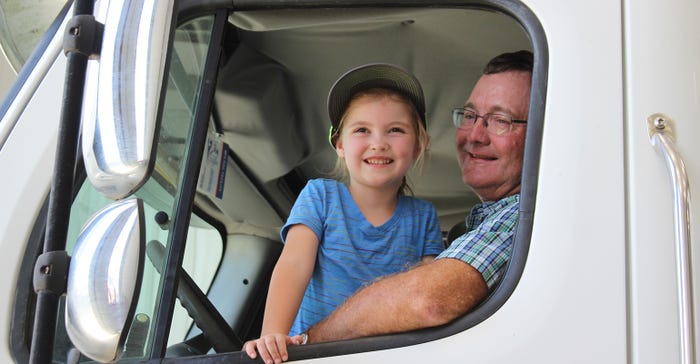
Dean Snyder drove his grain truck onto the weigh scale. His granddaughter, Abby Dorton, popped her head up above the dashboard. Pointing to the digital scale that was lit up with red lights, she turned to her grandfather as she read his name.

HISTORIC MOMENT: Dean Snyder wanted to celebrate the opening of MFA's first rail facility with family. His granddaughter, Abby Dorton, joined him to deliver grain during the grand opening.

Snyder, a local farmer from Hamilton, was one of the first to deliver grain to northwest Missouri's newest grain elevator. But it is not just any country elevator; it is the MFA Hamilton Rail Facility, with a capacity to move 60,000 bushels of grain per hour.
Located along Highway 36 in Caldwell County, this rail facility is MFA's largest single investment. It is a joint venture between MFA Inc., a grain marketing and farm supply cooperative, and MFA Oil Co., a farmer-owned energy supply cooperative.
The facility was designed to handle current and future advancements in farming and grain delivery.
Need for speed
Mitch Dawson, MFA's director of grain operations, says a lot has changed in farming. New technology at the farm level in seed, planting and harvesting requires more from local elevators. Farmers are raising more bushels and delivering it with semitrucks and semitrailers.
"Now what you want from us, and expect from us — especially when it comes to harvest — is speed, speed, speed and more speed," Dawson shares with a group of farmers gathering at the facility.

FASTER TURNAROUND: The new MFA Hamilton Rail Facility has a goal of getting farmers from scale to dump pit to scale in seven minutes.

Snyder is used to making the 100-mile trip to the Kansas City terminal, only to wait in the truck line for five hours before dumping grain. With the new MFA Rail Facility, he will travel nine miles and sit in a line for mere minutes. "The goal is a seven-minute turnaround from the time I get in line to the time I am out," he says.
Two dump pits with a volume of 1,500 bushels each connect to a 30,000-bushel-an-hour leg that will load railcars at a speed of 60,000 bushels per hour. The rail side accommodates 114 jumbo cars or 123 standard railcars. Known as a loop-loader facility, its circular railroad track design connects to Union Pacific Railroad's main line.
While the facility is meant to move grain, it also has temporary ground storage for 1.5 million bushels, and 2 million bushels of permanent grain storage on-site. The goal is to relieve some of the pressure at harvesttime for farmers and grain elevators.
"There is a lot of grain produced in north-central and northwest Missouri, and harvest is a critical time for farmers," Adam McIntyre, regional manager for MFA locations, says. "During high-volume periods, we can move grain from smaller elevators to the shuttle loader to keep local storage capacity available."
Location matters
In 2013, a little red Ford Fusion and gray Ford Taurus were traversing northwest Missouri from Polo to Trenton, looking for an ideal spot for MFA's Rail Facility.
Dawson looked at locations along the railroad line, county road conditions and accessibility. After months of travel, he settled on a site 4.9 miles from Hamilton. With its access to a four-lane highway, Highway 36, and proximity to the railroad, the bare piece of land was the right fit for the facility.
It took the approval from township and county board. Finally in 2016, construction started to pick up steam.
It took 13 months from the facility groundbreaking to dumping grain at an open house in June. Company officials say it will be in full working order come harvesttime in Missouri. Plans are in the works for an MFA Oil fueling station nearby.
Looking to the future
When MFA Inc. CEO Ernie Verslues pulls up to the rail facility, he says it has changed the skyline of Caldwell County. But it also shows the change in MFA's approach to the grain business.
Thirty years ago, grain receiving and marketing were not the core focus of the company. In fact, Verslues points out that the cooperative divested some grain assets. However, in recent years there has been a shift in business mentality.
"The company realized that there was a financial benefit to MFA Inc. and producers in the area of grain," he says. "As a company we began updating existing facilities, making enhancements and locating in strategic areas. Today, this facility furthers our commitment to the grain industry and raises it to another level."
He says the state-of-the-art MFA Rail Facility is built to last. Why? It is a company tradition. "MFA Inc. has been around 103 years, MFA Oil 88 years," he says. "Our company makes decisions for the long haul."
He says farmers can count on the new MFA Rail Facility to provide a high-speed grain facility for years to come — exactly what Snyder needs to hear.
"This (facility) is a big deal," Snyder says. "It is a new beginning for the future farmers in Caldwell County, and we wanted to be a part of it. It will be here a long time."
It was important that he share this moment in history with his granddaughter. She is the third generation. ""The goal is to pass down the farm to the next generation," he says." It will be nice to look back and see how we went across the scales together. Maybe one day, she will drive across it herself."
About the Author(s)
You May Also Like






